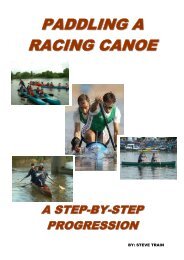The Science of Canoeing By Richard Cox
The Science of Canoeing By Richard Cox
The Science of Canoeing By Richard Cox
Create successful ePaper yourself
Turn your PDF publications into a flip-book with our unique Google optimized e-Paper software.
<strong>Canoeing</strong> Injuries:<br />
Causes, Prevention and Treatment<br />
It might appear reasonable to suppose that an apparently simple non-contact sport like canoeing should not<br />
induce injuries, but <strong>of</strong> course it does. <strong>The</strong> greater the volume and intensity <strong>of</strong> training, the greater the likelihood<br />
<strong>of</strong> injury. Paddling up to 70-80 miles a week or travelling in excess <strong>of</strong> 7 mph. will soon locate the vulnerable<br />
spots and there are few individuals who can cope with this sort <strong>of</strong> training for long without experiencing<br />
difficulties. <strong>The</strong> vast majority <strong>of</strong> canoeing injuries are caused by technique and/or training faults. Unfortunately,<br />
unlike running or swimming, canoeing has no large body <strong>of</strong> literature or cadre <strong>of</strong> physicians who understand the<br />
mechanics <strong>of</strong> the sport.<br />
What follows is a brief treatise on common problems experienced by paddlers and a few recommendations to<br />
prevent and/or treat them. Those wishing to delve a little further into the subject are advised to read the texts<br />
recommended on pp , especially the article by Walsh.<br />
As we look at canoeing injuries in this chapter, we will forget the canoeist bruised by the paddle blade <strong>of</strong> a<br />
fellow competitor or the paddler cut by an angler's fishing line and hook. <strong>The</strong>se injuries are hopefully infrequent<br />
and already adequately dealt with in general books on first aid. I will start with the subject <strong>of</strong> injury prevention,<br />
since this is perhaps the most important consideration.<br />
Flexibility<br />
Although a much discussed aspect <strong>of</strong> training, flexibility is that part <strong>of</strong> the training programme which is most<br />
conveniently left out when there are competing demands for time. Distances and times can easily be measured<br />
and written up in the daily log, but flexibility cannot. <strong>The</strong> greater your total weekly mileage and/or the intensity<br />
<strong>of</strong> your training, the tighter become your muscles and the more important flexibility exercises become.<br />
Numerous exercises are described in Appendix I-V. <strong>The</strong>se exercises should be included in the warm-up and<br />
warm-down routines <strong>of</strong> every training session. An adequate warm-up, particularly on a cold day, is important in<br />
preventing injuries.<br />
Progression<br />
Although it has already been mentioned several times, it is perhaps worth reiterating that training routines<br />
should be progressively increased and that there is no sudden alteration in intensity or in volume <strong>of</strong> work, as this<br />
predisposes the body to break down. As a rule <strong>of</strong> thumb, the increase in intensity and/or volume duration should<br />
not exceed 10 per cent per week.<br />
Not all injuries occur on the water, in fact, it is probably true to say that comparatively more take place in the<br />
weight training room. As cautioned on pxxxx, it is important to first establish good technique using light<br />
weights and to practise the exercises in adequate space having first checked the equipment for safety and<br />
recruited a couple <strong>of</strong> spotters to assist when necessary.<br />
Good technique on the water must also be established before intensive training is undertaken since this will help reduce the<br />
occurrence <strong>of</strong> injuries.<br />
Finally, good hygiene practices will reduce the chances <strong>of</strong> infection and bacteria entering the body. Blisters and<br />
abrasions for example, are less likely to turn septic following showering, application <strong>of</strong> antiseptic cream and<br />
regular thorough washing <strong>of</strong> clothing. Similarly, a good balanced diet should help prevent certain illnesses and<br />
assist recovery should they take hold.<br />
Blisters<br />
A common problem experienced by most canoeists at one time or another is blistered hands. <strong>The</strong> pressure <strong>of</strong> the<br />
skin rubbing on the shaft <strong>of</strong> the paddle, especially the control side, causes blisters on the pads <strong>of</strong> the fingers, on<br />
the inside <strong>of</strong> the base <strong>of</strong> the thumb and other prominent areas <strong>of</strong> the palm. Blisters are most likely to arise<br />
following a lay-<strong>of</strong>f, stepping up intensity or duration <strong>of</strong> training, using new paddles, using pogies or having one's<br />
hands wet over a long period <strong>of</strong> time.<br />
Unfortunately there is little one can do to prevent blisters although smooth surfaced wider shafted paddles have<br />
less <strong>of</strong> a tendency to rub them. Blisters also arise on the seat <strong>of</strong> many canoeists, especially following sprint<br />
training and marathon races. A little foam padding on the canoe seat can help, providing it is securely adhered.<br />
If you do get blisters, leave any small ones alone. If the blister is big and painful, first clean and disinfect the<br />
surrounding area thoroughly and relieve the pressure by draining. Sterilize a needle and insert it horizontally into<br />
the edge <strong>of</strong> the blister and allow the fluid to escape. Do not cut or tear the skin - leave it covering the blister with<br />
a waterpro<strong>of</strong> plaster to prevent infection. Surgical spirit will help harden the skin but must not be used if the<br />
surface has been broken. Should the blisters turn septic then it is important to seek medical attention.<br />
Lower-back Pain



